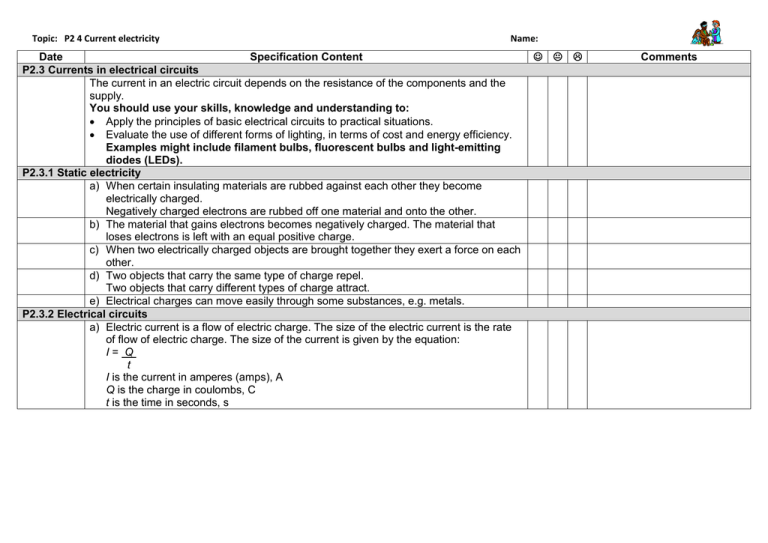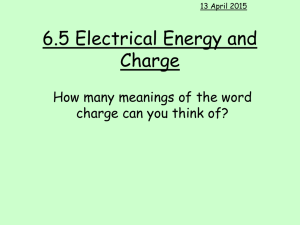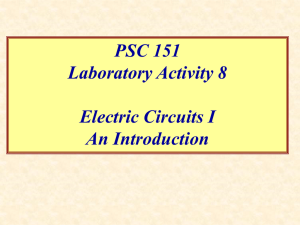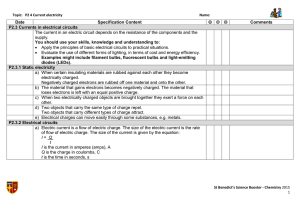P2 4 current electricity checklist
advertisement

Topic: P2 4 Current electricity Name: Date Specification Content P2.3 Currents in electrical circuits The current in an electric circuit depends on the resistance of the components and the supply. You should use your skills, knowledge and understanding to: Apply the principles of basic electrical circuits to practical situations. Evaluate the use of different forms of lighting, in terms of cost and energy efficiency. Examples might include filament bulbs, fluorescent bulbs and light-emitting diodes (LEDs). P2.3.1 Static electricity a) When certain insulating materials are rubbed against each other they become electrically charged. Negatively charged electrons are rubbed off one material and onto the other. b) The material that gains electrons becomes negatively charged. The material that loses electrons is left with an equal positive charge. c) When two electrically charged objects are brought together they exert a force on each other. d) Two objects that carry the same type of charge repel. Two objects that carry different types of charge attract. e) Electrical charges can move easily through some substances, e.g. metals. P2.3.2 Electrical circuits a) Electric current is a flow of electric charge. The size of the electric current is the rate of flow of electric charge. The size of the current is given by the equation: I= Q. t I is the current in amperes (amps), A Q is the charge in coulombs, C t is the time in seconds, s Comments Topic: P2 4 Current electricity Date Date Name: Specification Content b) The potential difference (voltage) between two points in an electric circuit is the work done (energy transferred) per coulomb of charge that passes between the points. V= W. Q V is the potential difference in volts, V W is the work done in joules, J Q is the charge in coulombs, C c) Circuit diagrams using standard symbols. The following standard symbols should be known: You will be required to interpret and draw circuit diagrams. Knowledge and understanding of the use of thermistors in circuits, e.g. thermostats is required. Knowledge and understanding of the applications of light-dependent resistors (LDRs) is required, e.g. switching lights on when it gets dark. Specification Content Comments Comments Topic: P2 4 Current electricity Name: d) Current–potential difference graphs are used to show how the current through a component varies with the potential difference across it. e) The current–potential difference graphs for a resistor at constant temperature. f) The resistance of a component can be found by measuring the current through, and potential difference across, the component. g) The current through a resistor (at a constant temperature) is directly proportional to the potential difference across the resistor. h) Calculate current, potential difference or resistance using the equation: V=IxR V is the potential difference in volts, V I is the current in amperes (amps), A R is the resistance in ohms, i) The current through a component depends on its resistance. The greater the resistance the smaller the current for a given potential difference across the component. j) The potential difference provided by cells connected in series is the sum of the potential difference of each cell (depending on the direction in which they are connected). k) For components connected in series: The total resistance is the sum of the resistance of each component. There is the same current through each component. The total potential difference of the supply is shared between the components. Topic: P2 4 Current electricity Date Name: Specification Content l) For components connected in parallel: The potential difference across each component is the same The total current through the whole circuit is the sum of the currents through the separate components. m) The resistance of a filament bulb increases as the temperature of the filament increases. You should be able to explain resistance change in terms of ions and electrons. (HT only) n) The current through a diode flows in one direction only. The diode has a very high resistance in the reverse direction. o) An LED emits light when a current flows through it in the forward direction. You should be aware that there is an increasing use of LEDs for lighting, as they use a much smaller current than other forms of lighting. p) The resistance of a light-dependent resistor (LDR) decreases as light intensity increases. q) The resistance of a thermistor decreases as the temperature increases. Knowledge of a negative temperature coefficient thermistor only is required. Comments







